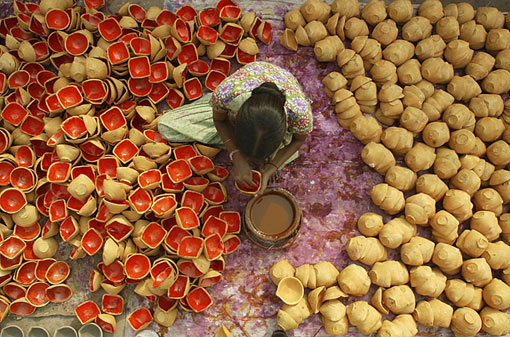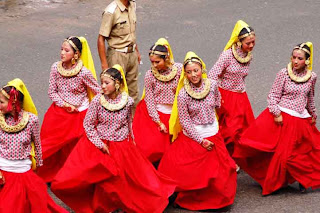Every winter,
When the great sun has turned his face away,
The earth goes down into a vale of grief,
And fasts, and weeps, and shrouds herself in sables,
Leaving her wedding-garlands to decay -
Then leaps in spring to his returning kisses.
~Charles Kingsley
Winter came down to our home one night
Quietly pirouetting in on silvery-toed slippers of snow,
And we, we were children once again.
~Bill Morgan, Jr.
Winter must be cold for those with no warm memories. ~From the movie An Affair to Remember
Merry Christmas & best wishes to you !!! <3 <3
Tuesday, December 13, 2011
Friday, October 28, 2011
Strawberry preserve - It taste so good ;) and how to make it?
The difference between a jam and a preserve is that with jam the fruits are broken up into a spreadable consistency, whereas with a preserve the fruits are, hopefully, preserved whole and suspended in their own jelly. To sterilise the jars for the preserve, wash them in warm soapy water, rinse well, dry with a clean tea cloth, and then pop them on to a baking sheet in a moderate oven for 5 minutes. Remember the jars should be warm when the preserve is added, so don't do this too far in advance. The following quantities make enough strawberry preserve to fill two 0.5 litre jars – small quantities are better for beginners, and for general preserving most of the time, because larger quantities take much longer to come to the boil, and the longer the boiling, the more the flavour and the colour of the fruit is spoiled.
 First of all hull 2 lb (900 g) strawberries and wipe each one with slightly dampened kitchen paper – don't wash them; wet strawberries will never make a preserve. If you can, always use slightly under-ripe strawberries and discard any that are bruised, or if they are not too badly bruised you can always eat them! Then layer them into the pan you are going to use, sprinkling them with 1½ lb (700 g) preserving sugar as you go. Always use a preserving pan if possible because it has a wide base so the juices will reduce down more quickly, and also when you're boiling the mixture furiously there will be no danger of it boiling over. Leave the fruit to soak in the sugar overnight, giving everything a stir around before you go to bed. When sugar comes into contact with the strawberries it does a wonderful job of hardening them, so that when they're subjected to fast boiling they have become tough enough not to disintegrate.
First of all hull 2 lb (900 g) strawberries and wipe each one with slightly dampened kitchen paper – don't wash them; wet strawberries will never make a preserve. If you can, always use slightly under-ripe strawberries and discard any that are bruised, or if they are not too badly bruised you can always eat them! Then layer them into the pan you are going to use, sprinkling them with 1½ lb (700 g) preserving sugar as you go. Always use a preserving pan if possible because it has a wide base so the juices will reduce down more quickly, and also when you're boiling the mixture furiously there will be no danger of it boiling over. Leave the fruit to soak in the sugar overnight, giving everything a stir around before you go to bed. When sugar comes into contact with the strawberries it does a wonderful job of hardening them, so that when they're subjected to fast boiling they have become tough enough not to disintegrate.  When you're ready to make the preserve, put four small plates into the freezer – these are to test for a set later. Place the pan over a fairly low heat and allow the sugar to dissolve slowly. Give the pan a shake from time to time, but only give very gentle stirs, as you want to try very hard not to break the fruit up.
When you're ready to make the preserve, put four small plates into the freezer – these are to test for a set later. Place the pan over a fairly low heat and allow the sugar to dissolve slowly. Give the pan a shake from time to time, but only give very gentle stirs, as you want to try very hard not to break the fruit up.  Before you begin to boil the mixture, it is absolutely necessary that all the crystals of sugar should be dissolved. To check this, you need to coat the back of the spoon with the juices and make sure that there are no crystals visible.
Before you begin to boil the mixture, it is absolutely necessary that all the crystals of sugar should be dissolved. To check this, you need to coat the back of the spoon with the juices and make sure that there are no crystals visible.  When the sugar has dissolved, turn the heat up to its highest setting, add the juice of 1 large lemon and as soon as the mixture is up to what old-fashioned cooks used to call a rolling boil, put a timer on for 8 minutes exactly.
When the sugar has dissolved, turn the heat up to its highest setting, add the juice of 1 large lemon and as soon as the mixture is up to what old-fashioned cooks used to call a rolling boil, put a timer on for 8 minutes exactly.  Then when the 8 minutes is up, remove from the pan from the heat, put a teaspoonful on to one of the chilled plates and allow it to cool completely. Then push the mixture with your little finger – if it begins to crinkle and sit up proudly without any liquid running out, the preserve is set. If not, re-boil for 3 minutes, remove from the heat, do a further test, and so on until the preserve is set.
Then when the 8 minutes is up, remove from the pan from the heat, put a teaspoonful on to one of the chilled plates and allow it to cool completely. Then push the mixture with your little finger – if it begins to crinkle and sit up proudly without any liquid running out, the preserve is set. If not, re-boil for 3 minutes, remove from the heat, do a further test, and so on until the preserve is set. Whatever you do, don't pour it straight into the jars; otherwise the strawberries will float to the top. You must leave it aside to settle for 15 minutes first. Gently stir in a small piece of butter (½ oz/10 g) if there's any scum – this should disperse it. Then pour into the warm sterilised jars. It's wise to invest in a proper jam funnel for this, as filling jars can be a very sticky business indeed without one.
Whatever you do, don't pour it straight into the jars; otherwise the strawberries will float to the top. You must leave it aside to settle for 15 minutes first. Gently stir in a small piece of butter (½ oz/10 g) if there's any scum – this should disperse it. Then pour into the warm sterilised jars. It's wise to invest in a proper jam funnel for this, as filling jars can be a very sticky business indeed without one.  Seal immediately with waxed discs, then cover with the lids or with Cellophane and elastic bands. Wait until the preserve is completely cold before labelling the jars, as the heat will prevent the labels sticking.
Seal immediately with waxed discs, then cover with the lids or with Cellophane and elastic bands. Wait until the preserve is completely cold before labelling the jars, as the heat will prevent the labels sticking. Source: deliaonline.com
Monday, September 12, 2011
Kind, the word that can change your life
And here's the proof.
It’s no secret being kind to others can lift your spirits as well as theirs. But research shows it is one of the most powerful tools we have for achieving optimum health, happiness and wellbeing. It can boost the immune system, improve physical and emotional wellbeing and stimulate the brain. And not just in the person carrying out the act. The recipient and onlookers also benefit.Author Dr Wayne Dyer says in his book The Power of Intention (Hay House): "Research has shown a simple act of kindness directed toward another improves the functioning of the immune system and stimulates the production of serotonin in both the recipient of the kindness and the person extending the kindness. Even more amazing is that persons observing the act of kindness have similar beneficial results."
Here’s the proof
In a Harvard University study, 132 students were shown a film about Mother Teresa. Researchers then tested the students’ saliva and found an immediate increase in immunoglobulin A (IgA), an antibody that plays a critical role in the immune system. When the students were shown a film about Attila the Hun, their antibody levels droppe.The brain changes
Giving activates pleasure-related centres in the brain. Research at the National Institutes of Health in the US found when people thought about giving money to a charity, the parts of the brain normally associated with "selfish" pleasures, such as eating and sex, lit up.A similar study at Emory University in the US found helping others lit up the same part of the brain as receiving rewards or experiencing pleasure.
The Social Capital Community Benchmark Survey, overseen by Harvard University researchers, found those who volunteered time or money were 42 per cent more likely to describe themselves as happy.
Pass it on
Research conducted by the University of Cambridge in the UK found when we see someone helping another person, it not only gives us a good feeling, it causes us to go out and do something good for someone else.Researchers showed 30 students a nature documentary and another 30 an uplifting segment from Oprah.
All viewers were then asked to voluntarily help with another task. Almost 70 per cent of those who had watched the Oprah segment volunteered to help compared with 40 per cent of those who had watched the documentary.
Source: http://www.bodyandsoul.com.au/
Wednesday, August 24, 2011
Loving you....♥ ♥
Loving you is easy
I can do it in my sleep
I dream of you so often
It's like you never leave
_ Bright eyes _
(Source: tumblr.com via somebody-that-i-used-to-know )
Sometimes, no matter
how much faith we have,
we lose people.
But you never forget them.
And sometimes,
it's those memories
that give us the strength to go on.
Whenever we're apart
it feels like a part of me is missing...
and then I remember,
you have my heart ♥ ♥
People always think that the most painful thing is losing the one you love in your life.
The truth is...
The most painful things is losing yourself in the process of loving someone too much.
Forgetting that
You are SPECIAL too!
I love you not because I need you,
But I need you because I love you.
Source : collection
Tuesday, August 16, 2011
Tuesday, August 9, 2011
Diwali fetival in October and November in India
Diwali is a five day festival that represents the start of the Hindu New Year. It honors the victory of good over evil, and brightness over darkness. It also marks the start of winter. Diwali is one of the most popular Indian festivals. It is celebrated 20 days after Dussehra, on Amavasya - the 15th day of the dark fortnight of the Hindu month of Ashwin (Aasho) in (Oct/ Nov) every year. This occasion is mentioned in the religious books as stating its origin, when Lord Rama returned to this kingdom Ayodhya after 14 years of exile.
The whole kingdom was lit up with divas (earthen lamps) to celebrate his return. To this day houses all over India glow with the twinkle of innumerable divas, candles and lights on Diwali day.
On the third day, lots of small clay lamps (called diyas) and candles are lit and placed in houses, and fireworks are let off everywhere, giving Diwali its name of “Festival of Lights”. People also clean and decorate their homes with Rangoli (Hindu folk art), buy new clothes, gamble, and give each other gifts and sweets during the festival.
The candlelight makes Diwali a very warm and atmospheric festival, and it's observed with much joy and happiness. However, be prepared for lots of loud noise from the fireworks and firecrackers going off. The air also becomes filled with smoke from the firecrackers, which can add to breathing difficulties.
It's a good idea to protect your hearing with ear plugs during Diwali, especially if your ears are sensitive. Some crackers are extremely loud, and sound more like explosions. The noise is very damaging to hearing.
The whole kingdom was lit up with divas (earthen lamps) to celebrate his return. To this day houses all over India glow with the twinkle of innumerable divas, candles and lights on Diwali day.
Throughout the whole of India. However, the festival isn't widely celebrated in the state of Kerala, as it's not part of their culture. This is because Diwali has traditionally been a festival of wealth for merchants, and being a Communist-ruled state, the Hindus of Kerala have never freely engaged in trade.
One of the best places to experience Diwali is in the "pink city" of Jaipur, in Rajasthan. Each year there's a competition for the best decorated and most brilliantly lit up market. It's a dazzling display that attracts visitors from all over India.
 | |||
| Festival of Light |
 | |
| Preaparing for Festival |
The candlelight makes Diwali a very warm and atmospheric festival, and it's observed with much joy and happiness. However, be prepared for lots of loud noise from the fireworks and firecrackers going off. The air also becomes filled with smoke from the firecrackers, which can add to breathing difficulties.
It's a good idea to protect your hearing with ear plugs during Diwali, especially if your ears are sensitive. Some crackers are extremely loud, and sound more like explosions. The noise is very damaging to hearing.
 | ||
| Candles for Diwali |
Sunday, July 31, 2011
Tuesday, July 5, 2011
Monday, June 27, 2011
Wednesday, May 18, 2011
Have you ever come to Sikkim - India?
Sikkim is simply enchanting. Whether you're gazing upon the white-gold peaks of mighty Khangchendzong (the world's third highest mountain) or responding to the shy smile of a Lepcha tea stall owner, it's not hard to understand why Buddhism, the gentle faith, remains rooted in this hard, but tranquil land. The Buddha is everywhere, in the exhilarating purity of the mountain air, the blue-green waters of the Teesta River and the dignified friendliness of Sikkim's people.
Coming here, you will be welcomed by friendly local people.
Nepali festival is one of the interesting festivals in Sikkim. Maghe Sankranti (January): It corresponds to the Indian festival of Makara
 Sankranti and is marked by people bathing in holy rivers.
Sankranti and is marked by people bathing in holy rivers.
Dasain (September-October): This is the Nepali version of the nine-day long Durga Puja. The first day of festival, called Ghatasthapana, sees the installation of the kalash or sacred vassel in the family Puja room. Prayers are chanted to invoke the Goddess Durga and persuade her to alight on the rim of the kalash, even if it be for as long as a mustard seed can balance on the horn of cow.
Tihar (November): A five-day festival, its third day corresponds to the Indian festival of Diwali. The first day is celebrated as kag tihar or the festival of crows, when delicacies are prepared and fed to the crows; then comes kukoor tihar or the festival of dogs; then gai tihar, whose evening is devoted to the celebration of the Goddess Lakshmi and houses are decorated with lights; the following day is goru (ox) tihar. The last day is Bhai Tika, when sisters mark their brothers foreheads with tikas
Momos are the most popular dishes that have made it big outside Sikkim. Today, you will get a Momo in any part of the country, at any eating joint. They are flour dough in the shape of dumblings and are stuffed generally with minced meat. Though there are varieties in which vegetables or cheese used as a filling. They flour dough is steamed for 30 minutes in a peculiar utensil which has three compartments. In the lowest compartment, soup is boiled. The steam which rises from the soup, cooks the dumblings. Momos are eaten hot with the soup, chilly sauce or tomato pickle.
Red panda is the state animal of Sikkim, it is also the mascot of the International Tea Festival in Darjeeling. They are mostly herbivorous mammals, specialised as bamboo-feeders; they cannot digest cellulose as their guts are not specialised to handle plant matter like that of cows, horses and other herbivorous mammals. They eat berries, fruit, mushrooms, roots, acorns, lichen, grass and are known to supplement their with the occasional young birds, fish, eggs, small rodents and insects when the weather is warm enough. In captivity they will readily eat meat.
Source: Internet
 |
| Crows Lake in North Sikkim |
Coming here, you will be welcomed by friendly local people.
Nepali festival is one of the interesting festivals in Sikkim. Maghe Sankranti (January): It corresponds to the Indian festival of Makara
 Sankranti and is marked by people bathing in holy rivers.
Sankranti and is marked by people bathing in holy rivers. Dasain (September-October): This is the Nepali version of the nine-day long Durga Puja. The first day of festival, called Ghatasthapana, sees the installation of the kalash or sacred vassel in the family Puja room. Prayers are chanted to invoke the Goddess Durga and persuade her to alight on the rim of the kalash, even if it be for as long as a mustard seed can balance on the horn of cow.
Tihar (November): A five-day festival, its third day corresponds to the Indian festival of Diwali. The first day is celebrated as kag tihar or the festival of crows, when delicacies are prepared and fed to the crows; then comes kukoor tihar or the festival of dogs; then gai tihar, whose evening is devoted to the celebration of the Goddess Lakshmi and houses are decorated with lights; the following day is goru (ox) tihar. The last day is Bhai Tika, when sisters mark their brothers foreheads with tikas
Momos are the most popular dishes that have made it big outside Sikkim. Today, you will get a Momo in any part of the country, at any eating joint. They are flour dough in the shape of dumblings and are stuffed generally with minced meat. Though there are varieties in which vegetables or cheese used as a filling. They flour dough is steamed for 30 minutes in a peculiar utensil which has three compartments. In the lowest compartment, soup is boiled. The steam which rises from the soup, cooks the dumblings. Momos are eaten hot with the soup, chilly sauce or tomato pickle.
 | |
| Thukpa - the delicious food in Sikkim |
 | ||
| Red panda |
Source: Internet
Subscribe to:
Posts (Atom)



































